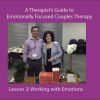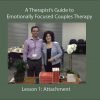How to Resolve Recurring Conflicts in Your Relationship:
John Gottman, one of the most acclaimed researchers on couples conflict, has argued that about two thirds of all issues couples argue about are irresolvable. He calls these issues, perpetual conflictsand they consist of difference in taste and habit that are so deeply ingrained in us that they have become part of our personality.
Perpetual problems might include issues such as one person being a home body and another person being a social butterfly, or one person having a relaxed attitude to life, while another is a go-getter who needs to get things done right away.
From an emotionally-focused couples therapy perspective these differences, while annoying at times, are not really that important as long as couples feel respected by each other and connected with each other. However, when this is not the case, all hell breaks lose, and they become a battleground of conflict.
At such times, many little things about our partner can become annoying, including things we would previously just have shrugged off, or laughed about.
The real insight, however, is that the little things we end up disagreeing about or find annoying are not the real issues that need to be talked about, but instead stand-ins for these issues.
In other words, the real issue is not whether or not our partner once again didn’t do the dishes, or once again didn’t call or text all day. The real issue is what that represents to the person who gets antagonized by it.
From an emotionally-focused couples therapy perspective it is therefore important to take a step back from the many little conflicts in our everyday lives and ask ourselves: what is the real problem here?
Why We Often Get Stuck in Our Conflicts:
At first the problem might seem to be tantamount to what our anger tells us it is.
Our partner is inconsiderate, self-absorbed, overly emotional, too uninvolved, too needy, or any such host of angry complaints that immediately come to our mind.
The problem with stopping our self-analysis here is that it often leaves us at loggerheads with our partner:
- We think our partner is inconsiderate – they think we are overreacting
- We think our partner is uninvolved – they think we need to give them their space
- We think our partner has lost interest in us – they think we have unrealistic standards and can’t accept them for who they are
In these types of situations, there is really no solution to our relationship problems, because what we want and what our partner wants are two different things.
A Linear Solution Cannot Solve a Circular Problem:
A break-through, however, is achieved when we realize that our problems are not separate from each other, and cannot therefore be solved by simply asking that our partner change something about themselves.
We then stop looking for a linear solution to a circular problem.
What do I mean by that?
A linear definition of a problem involves identifying a cause of a specific problem in one or the other person and eliminating the cause by asking the person who is causing the problem to change.
A circular problem, on the other hand, is one where how I deal with my emotions impacts how you deal with yours, and how you talk to me impacts how I talk to you.
In these situations, the problem is co-created and the solution must therefore be a joint effort to create a different outcome. The problem is here not you or me, but how we each play a role in perpetuating a shared negative pattern.
A Frequent Pattern Couples Get Stuck In:
A frequent pattern that happens in relationships is that one person becomes critical of their partner because they experience their partner as distant and disconnected, and that the other person becomes distant and disconnects because they experience their partner as always criticizing them and therefore not a safe person to get close to.
Or to flip it around: One person becomes disengaged because the other person is hard to please and always complains about something, and the other person gets dissatisfied and critical because the first person disengages.
In both of these scenarios, there is not a single cause and a single person who is the reason for the problem. The problem is circular in the sense that the way each person acts becomes a problem for the other.
In couples therapy this is often the first fruitful realization that partners need to have. They need to understand that they each play a part in perpetuating the problems they don’t like in their relationship. It is not just the other person’s fault.
A couple jointly produces each other’s misery and they therefore need to work together to jointly realize the impact they are having on each other.
The Way Out of a Stalemate:
To work their way out of their negative pattern, the critical partner needs to get a glimpse of the fears and bad feelings that make the withdrawn partner shut down in self-protection, and the withdrawn partner needs to get a glimpse of the fears and bad feelings that makes the critical partner critical.
Then they might learn that the critical partner is being critical because she has deep fears that she is not worth connecting with and is terrified of not mattering to the withdrawn partner and being utterly alone in this world. They might also learn that the withdrawn partner is withdrawn because he is afraid deep down that who he is not enough and that his failure to make his partner happy is really about some fundamental inadequacy or character flaw about him.
Unfortunately when fears are not talked about, the way each person is dealing with them on their own, only ends up contributing to the fears of the other person. By becoming critical in pursuit of more engagement or withdrawing to protect oneself from feeling inadequate, a never-ending vicious cycle of fear-based emotions and reactions is created that leaves each person feeling alone and unloved.
Only when a couple makes a commitment to address a common problem they are in together is there hope for them to get themselves out of it.
Addressing Real Issues instead of Surface Problems:
By learning to speak the full truth behind their criticism and disengagement they can excavate the positive needs and longings, which they each have to be loved, important, and accepted.
Now instead of talking about the dishes that were not put away or the absence of communication, they can talk about the real problems, which are their doubts and fears about whether or not they matter to each other and can be loved for who they are.
Once a relationship proceeds from this deep level of understanding and knowing, partners no longer have to feel alone with their relationship fears, but can work together to overcome them. Now as a team, one person’s feelings do not become a problem for the other, but an opportunity to reassure them that they are needed and wanted.
Rather than pointing fingers or blaming the other person, the feelings that previously had to go underground because they were too vulnerable, can now come to the forefront. Instead of angry accusations, the conversation now becomes about softer longings, and instead of disengaging, the conversation now becomes about an assertive desire to be accepted and given a chance to do it right.


























